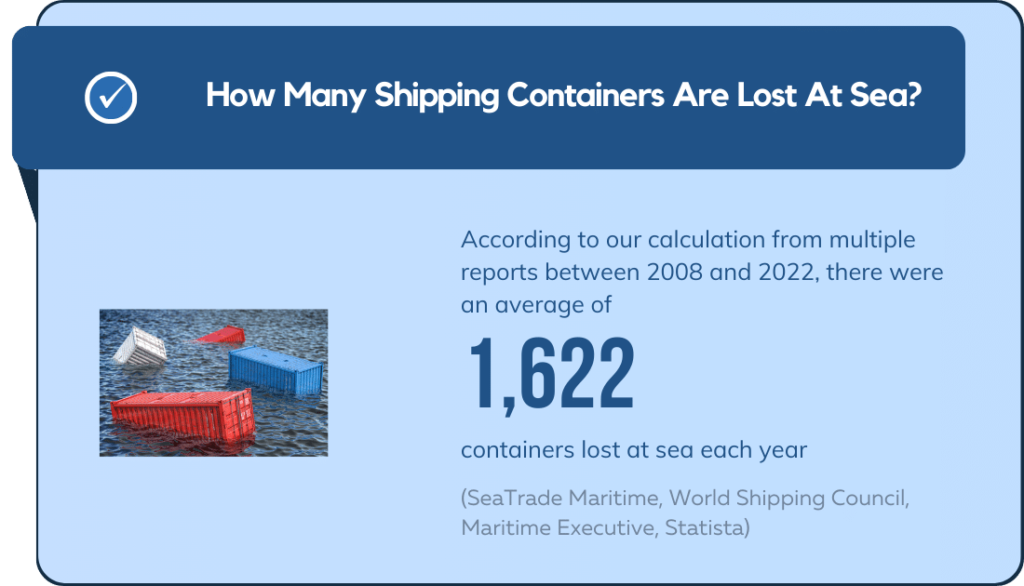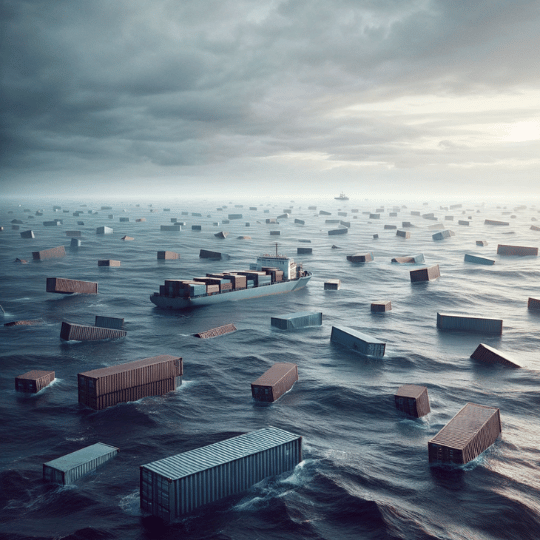How many shipping containers are lost at sea each year?
According to our calculation from multiple reports, between 2008 and 2022, there were an average of 1,622 containers lost at sea each year. In recent years, the number of containers lost at sea has fluctuated. According to the WSC Containers Lost at Sea Report covering 2020-2021, containers lost overboard represent less than 1% of the roughly 226 million containers shipped each year. In the 2020-2021 period, 3,133 containers were lost overboard, compared to 779 in the previous three years.

Lets look at the numbers of shipping containers are lost at each year.
Shipping Containers Lost At Sea By Year
| Year | # of Shipping Containers Lost at Sea |
|---|---|
| 2023 | ** |
| 2022 | 661 |
| 2021 | 3,133 |
| 2020 | 3900 |
| 2019 | 500 |
| 2018 | 1430 |
| 2017 | 420 |
| 2016 | 1530 |
| 2015 | 1200 |
| 2014 | 1460 |
| 2013 | 5590 |
| 2012 | 960 |
| 2011 | 1520 |
| 2010 | 940 |
| 2009 | 590 |
| 2008 | 500 |
Are shipping containers lost at sea recovered?

Recovering shipping containers that get lost at sea is an extremely difficult task. When these containers sink down to the ocean floor, especially at depths of thousands of feet, retrieving them becomes a formidable challenge. Even those that stay afloat can pose problems, as they often drift far from where they were lost. These floating containers can remain on the surface for several weeks before sinking.
A significant obstacle in this situation is the absence of international laws mandating the reporting of lost containers, except for those containing hazardous materials. As a result, most container losses go unreported and, subsequently, unrecovered. Recovery efforts are primarily focused on containers with hazardous content that end up on shores, in an attempt to reduce environmental and safety hazards.
In some rare cases, efforts are made to track and recover significant losses of containers, such as the incident with the Tokio Express Lego spill. However, these recovery and cleanup operations are often expensive and complex. Advances in technology, like the use of underwater robots, have helped in retrieving some containers from the seafloor, but the majority remain lost.
Due to the immense difficulties and high costs involved, it is likely that the vast majority of containers lost at sea are never recovered. Therefore, preventing these losses by improving shipping practices is crucial. Shipping companies need to prioritize enhancing safety measures and preventing the loss of containers, rather than relying on the slim possibility of recovery after an incident.
Most Expensive Container Lost At Sea
Container ship accidents can result in huge economic losses from damaged and lost cargo. Historically, some of the most valuable cargo lost at sea includes precious metals, jewels, and artifacts that would be worth billions today if recovered.
Here are the list of most expensive container ship accidents and cargo lost at sea:
- The ONE Apus lost over 1,800 containers in the Pacific Ocean in 2020, one of the largest losses of containers at sea. Total losses estimated at $200 million.
- The MOL Comfort broke in half and sank in 2013 with 4,293 lost containers. Insurance claims exceeded $400 million.
- The MV Rena ran aground in New Zealand in 2011 spilling oil and containers. Cleanup costs exceeded $700 million.
- The Ever Given blocked the Suez Canal for 6 days in 2021, delaying $9 billion in trade per day.
- The Titanic sank in 1912 with cargo worth over $7 million at the time. Artifacts recovered in the 1980s-90s valued at $200 million.
- The Flor de la Mar, a Portuguese ship lost in 1511, may have carried up to 80 tons of gold, 200 chests of jewels, and other treasures worth over $2 billion today.
- The treasure fleet of 1715 that sank during a hurricane off Florida contained gold and silver worth up to $400 million total.
- The Amber Room, looted by Nazis in WWII, contained gold decorations and precious jewels. Estimated value is $500 million if found.